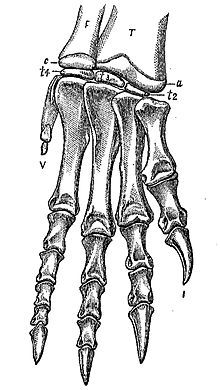Ammosaurus
|
Ammosaurus Temporal range: Early-Middle Jurassic |
|
|---|---|
 |
|
| Illustration of the foot bones | |
| Scientific classification | |
| Kingdom: | Animalia |
| Phylum: | Chordata |
| Class: | Reptilia |
| Clade: | Dinosauria |
| Order: | Saurischia |
| Suborder: | †Sauropodomorpha |
| Clade: | †Anchisauria |
| Genus: |
†Ammosaurus Marsh, 1891 |
| Species: | †A. major |
| Binomial name | |
|
Ammosaurus major (Marsh, 1889) |
|
| Synonyms | |
|
|
Ammosaurus (/ˌæmoʊˈsɔːrəs/; "sand lizard") is a genus of sauropodomorph dinosaur from the Early and Middle Jurassic Period of North America. At 4 meters (13 feet) in length, it was small compared to some other members of its suborder, which included the largest animals ever to walk the Earth. Gregory S. Paul estimated its weight at 70 kg in 2010. It was a versatile animal, able to move both bipedally and quadrupedally, and may have been omnivorous. Remains have been discovered outside Connecticut but these are only tentatively, if at all, referred to Ammosaurus.
The generic name Ammosaurus is derived from the Greek words "ἄμμος" ("ammos" as "sandy ground") and "sauros" ("lizard"), referring to the sandstone in which it was found and its reptilian nature. There is one currently valid species (Ammosaurus major), which is so named because it is larger than Anchisaurus, of which it was originally considered a second species, Anchisaurus major. Famous American paleontologist Othniel Charles Marsh created this specific name in 1889. In 1891, Marsh created the new genus Ammosaurus for this species. He subsequently named another species of Anchisaurus in 1892: Anchisaurus solus, based on a juvenile specimen, YPM 209, from the same quarry Ammosaurus major was found in. In 1932 Friedrich von Huene renamed this to Ammosaurus solus. Scientists now consider it synonymous with Ammosaurus major.
...
Wikipedia
